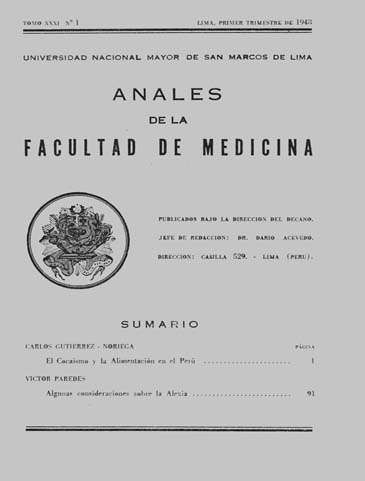The cocaísmo and food in Peru
DOI:
https://doi.org/10.15381/anales.v31i1.9617Abstract
The cocaísmo, according to the thesis that is developed in this paper is the result of poor diet of the peoples of the Andean region which prominently has developed. The arguments underlying this thesis are as follows: During the Inca Empire, when the Andean people were very well fed, coca habit was almost unknown, using this drug mainly in religious worship. The Incas banned the use of coca, and this plant crops other than occupy very restricted areas, belonged exclusively to the Inca and temples. Data on cocaísmo before the Inca Empire are scarce, but some reveal that the first rulers of Cuzco expelled coqueros primitive peoples to the jungle region. Clearly the coca habit spread considerably after the Conquest of Peru, and the cultivation and the drug trade became much larger proportions to which I had at the time of the Incas. The spread of cocaísmo originated around the same time that, because of the war of conquest and change of organization in the country, there was a considerable decline of agriculture and production, and practically almost complete destruction of the early cattle industry Andean region. The latter according to the testimony of all historians, was the main wealth of this region, and its destruction was due to a catastrophic national impoverishment. The occurrence of vagrants and beggars in alarming proportions noted in the same period. Begging, vagabundismo and food shortages were unknown phenomena during the Inca Empire. In addition, some historical data show that the Andean town was subjected to poverty and deprivation of all kinds as a means of passive resistance. The -droga coca acts as a narcotic vital sensations, as suppresses hunger, fatigue weakened organisms, thirst, cold, and the most basic human aspirations - in these circumstances was an essential factor to adapt the organism to so deficient and abnormal living conditions. This drug has acted as a special assistant of the Andean people for four centuries to cope with the most extreme misery. Current research, according to data provided by the story, they also demonstrate the close link between cocaísmo and misery, especially among the cocaísmo and insufficient food. In regions of increased consumption of cocaine - of 2-4 Kgs. annual per capita average - the daily food ration is 767 grams. for the average of the inhabitants; in regions where the cocaísmo is less intense, where it is consumed 1-2 Kgs of cocaine per year, the average food ration is 904 grams per inhabitant.; and in regions where the cocaísmo is minimal, 0.1 Kg. Coca annual per capita food ration is 1096 grams. day on average. Food rations prevailing in the provinces of intense cocaísmo not provide the minimum calorie indispensable support human life. The number of calories in such portions is less than 2000, the minimum needed to keep working peasant, 3000-4000 calories. Coca, of course, has absolutely no nutritional value v energy. Since in regions of heavy cocaísmo no excessive consumption of alcohol, it is likely that at least part of the physiological calories is in certain cases provided by alcohol. Since this is not a food substance and is so toxic and dangerous as cocaine, its toxic effects on the body and inheritance are added to this alkaloid. In all regions of Peru food is poor because they are lower in protein and vitamins, but this deficit is much higher in regions cocaístas. Food in the latter is not only deficient by low energy, but also for poor in protein, fats and vitamins, substances contained in physiological quantities less than minimum. The problem of the relationship between food and cocaísmo is worsening 011 alarming and progressive, as can be seen in recent years, while a decline in production and consumption, a considerable increase in production and consumption coca, which is nearly 200.000 to 500.000 Kgs. annual. Is observed at the same time a parallel increase in the production and consumption of alcohol. It is urgent to render immediate action to reduce the production of both toxic substances and avoid an increase in their respective addictions. Whether to replace coca crops and sugar cane for the production of brandy, for food crops is suggested. All plans to combat cocaísmo and alcoholism, and drug production behind them, must march coordinated with plans to improve food production and supply of the inhabitants of the Andes, and other necessary steps to improve their living conditions and save him from drug addiction.Downloads
Published
1948-03-15
Issue
Section
Trabajos originales
License
Copyright (c) 1948 Carlos Gutiérrrez Noriega

This work is licensed under a Creative Commons Attribution-NonCommercial-ShareAlike 4.0 International License.
Those authors who have publications with this magazine accept the following terms:
- Authors will retain their copyrights and guarantee the journal the right of first publication of their work, which will be simultaneously subject to Creative Commons Attribution License that allows third parties to share the work as long as its author and its first publication this magazine are indicated.
- Authors may adopt other non-exclusive licensing agreements for the distribution of the version of the published work (eg, deposit it in an institutional electronic file or publish it in a monographic volume) provided that the initial publication in this magazine is indicated.
- Authors are allowed and recommended to disseminate their work over the Internet (eg: in institutional telematic archives or on their website) before and during the submission process, which It can produce interesting exchanges and increase quotes from the published work. (See El efecto del acceso abierto ).
How to Cite
1.
Gutiérrrez Noriega C. The cocaísmo and food in Peru. An Fac med [Internet]. 1948 Mar. 15 [cited 2024 Jul. 17];31(1):1-90. Available from: https://revistasinvestigacion.unmsm.edu.pe/index.php/anales/article/view/9617















